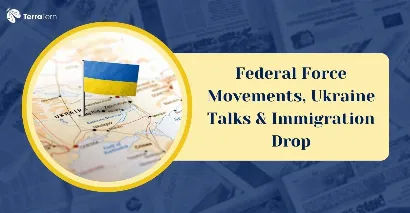Key Highlights
During a stormy period of US policy shifts during the month of August 24, 2025, President Donald Trump dramatically increased federal activity in the large cities, caused international anxiety with his actions, and oversaw a dramatic decrease in immigrant flows. The contentious choices, such as the use of the National Guard in numerous cities, derailed peace efforts in Ukraine, and hard-line policies on immigration, are recounted and reinterpreted in the light of the political theatre.
1. National Guard Deployments: Expanding Federal Presence
Washington, D.C.: Armed Troops on the Streets
In the late evening on August 24, National Guard forces that had been on the ground in the nation's capital were instructed by law enforcement to carry service-issued firearms, including M-17 pistols and M-4 rifles, with the requirement under the official guidelines that the use of lethal force would only be under imminent threat conditions. The transition in the role of civilian control and the presence of the unarmed Guard to that of armed federal forces confronted a broad range of concern and opposition.
Plans to Target Chicago
This comes after Pentagon officials have confirmed to ABC News that action is afoot to send units of the National Guard to Chicago in spite of local opposition. House Minority Leader Hakeem Jeffries cried that Trump has created a crisis in order to do this, and the mayor of Chicago dealt with it as the most egregious undermining of the Constitution that has taken place around the 21st century.
Also Read: Build Your Future with the Federal Skilled Worker Program
Baltimore in the Crosshairs
In a similar vein, Trump said he could send troops to Baltimore due to rising crime. Governor Wes Moore, a military veteran, criticised the measure as racial scare tactics when, in fact, the murder rate in Baltimore had decreased by some 20%.
Broader Guard Mobilisation Across States
Beyond direct urban deployments, the administration is deploying to 19 states under Title 32 the authority of between 1,600 and 1,700 National Guard troops to assist DHS with immigration- and crime-related administrative duties, which could include transportation, photographing, fingerprinting, and collecting DNA of individuals in ICE custody.
2. Diplomatic Manoeuvres: Ukraine Peace Process Falters
Lavrov’s Praise, Vance’s Caution
In an apparent change of tack, Russian Foreign Minister Sergey Lavrov has commended both the attempt at peace in Ukraine by Trump, compared to the lack of action seen in Europe and also minimised the targeting of civilians. At the same time, U.S. Vice President JD Vance confirmed that the focus on the issue in Washington would continue its diplomacy, albeit that peace will not come fast and easy.
Also Read: Uncloaking the Non-Citizen Voting in U.S. Federal Elections
Anchorage Summit Yielded No Breakthrough
In spite of a highly promoted Trump-Putin summit in Anchorage in early August, no breakthroughs were made. More critics believe President Trump is preparing Ukraine as a territory to make concessions as a country on the condition of a peace deal. Former Ukrainian President Zelensky called on the United States not to abandon its ally during the gift stalemate on the occasion of Ukrainian Independence Day.
3. Immigration Downtrend: Enforcement and Deportation
Immigrant Numbers Slide Sharply
Since the second term of Trump started in January, the number of immigrants in the United States decreased by more than one million, from 53.3 million to 51.9 million, and the share of the immigrant workforce fell to 19%, the lowest since last year when the policies began to skyrocket.
Deportation Controversies & Sanctuary Fightbacks
Kilmar Historic U.S. officials are seeking the deportation of Kilmar Abrego Garcia to Uganda due to unresolved gang affiliation and possible administrative defects. Meanwhile, a federal judge prevented an attempt by the Trump administration to withhold funding made to 34 so-called sanctuary cities, deepening this growing policy tug of war.
4. Fresh Flashes: Broader Political Ripples
Tariff Strategy Solidifies
Trump’s sweeping tariffs are establishing deeper roots. Observers caution that they may persist across future administrations due to entrenched political and economic incentives.
Intel Gets Federal Boost
The U.S. government is also participating in a strategic industrial shift, purchasing a 10% share of Intel and financing via the CHIPS Act to increase domestic semiconductor production. Trump referred to the deal as a great deal, which is an embodiment of the national strategy by economic security.
Also Read: 6 Key Factors of Federal Skilled Worker Program
Bolton Targeted by the FBI
On August 22, the FBI searched the house of former national security adviser John Bolton with regard to classified documents. For Trump, definitely, the raid brought him close enough to withstand the ruckus of further politicisation of the law enforcement entity and questions regarding the impartiality of the law.
Conclusion
With the rush of militarisation of the streets of the U.S. and the tense relations with Russia, contraction of the immigrant communities and risking economic actions, Trump is leaving his mark in various areas, which is accompanied by extreme political polarity. These rapid changes highlight a governing philosophy that deploys authority in a blanket fashion--questions of constitutional extent, geopolitical strategy, and the effect on society arise in the next several months.
To stay updated about the latest immigration news, contact TerraTern right away!








